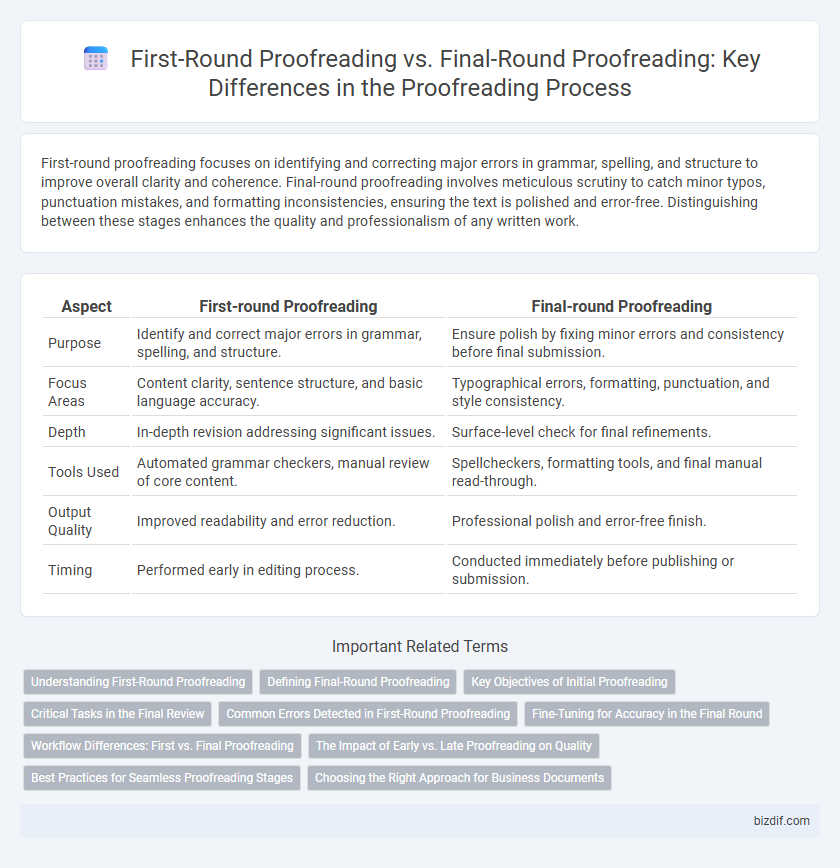First-round proofreading focuses on identifying and correcting major errors in grammar, spelling, and structure to improve overall clarity and coherence. Final-round proofreading involves meticulous scrutiny to catch minor typos, punctuation mistakes, and formatting inconsistencies, ensuring the text is polished and error-free. Distinguishing between these stages enhances the quality and professionalism of any written work.
Table of Comparison
| Aspect | First-round Proofreading | Final-round Proofreading |
|---|---|---|
| Purpose | Identify and correct major errors in grammar, spelling, and structure. | Ensure polish by fixing minor errors and consistency before final submission. |
| Focus Areas | Content clarity, sentence structure, and basic language accuracy. | Typographical errors, formatting, punctuation, and style consistency. |
| Depth | In-depth revision addressing significant issues. | Surface-level check for final refinements. |
| Tools Used | Automated grammar checkers, manual review of core content. | Spellcheckers, formatting tools, and final manual read-through. |
| Output Quality | Improved readability and error reduction. | Professional polish and error-free finish. |
| Timing | Performed early in editing process. | Conducted immediately before publishing or submission. |
Understanding First-Round Proofreading
First-round proofreading focuses on identifying and correcting major errors in grammar, structure, and factual accuracy, which ensures the overall coherence and clarity of the document. This stage targets inconsistencies, incomplete revisions, and formatting issues that could undermine the content's quality. Thorough understanding of first-round proofreading allows for a more efficient and effective final-round review by minimizing basic mistakes early in the editing process.
Defining Final-Round Proofreading
Final-round proofreading is the last step in the editing process, focused on catching any remaining typographical, grammatical, and formatting errors before publication or submission. This stage ensures consistency in style, accuracy in layout, and completeness of corrections made during earlier rounds. By thoroughly checking for overlooked mistakes, final-round proofreading guarantees the polished and professional quality of the final document.
Key Objectives of Initial Proofreading
First-round proofreading primarily targets the detection and correction of major errors in grammar, spelling, and punctuation to ensure the document's overall clarity and coherence. This stage emphasizes identifying inconsistencies, formatting issues, and factual inaccuracies to improve the manuscript's structure and readability. By addressing these fundamental elements early, initial proofreading lays the groundwork for a polished and professional final submission.
Critical Tasks in the Final Review
Final-round proofreading focuses on critical tasks such as verifying consistency in formatting, correcting overlooked typographical errors, and ensuring accuracy of references and citations. It also involves a meticulous check of punctuation, grammar, and adherence to style guides to guarantee the document's professionalism. This stage is essential for catching subtle mistakes missed during the first-round proofreading and preparing the text for publication.
Common Errors Detected in First-Round Proofreading
First-round proofreading primarily detects common errors such as spelling mistakes, grammatical inaccuracies, punctuation issues, and formatting inconsistencies, ensuring the text meets basic language standards. This initial stage often identifies incorrect word usage, subject-verb agreement errors, and typographical errors that can disrupt readability. Final-round proofreading, by contrast, focuses on refining style, tone, and consistency, addressing any lingering issues missed during the first round.
Fine-Tuning for Accuracy in the Final Round
First-round proofreading primarily targets broad errors such as grammar, punctuation, and consistency issues, laying the groundwork for a polished document. Final-round proofreading fine-tunes the text by meticulously verifying facts, refining word choice, and enhancing clarity to ensure complete accuracy and professionalism. This detailed review in the final stage is essential for eliminating subtle mistakes and optimizing overall coherence.
Workflow Differences: First vs. Final Proofreading
First-round proofreading primarily focuses on identifying and correcting major errors in grammar, structure, and content consistency, establishing a foundational accuracy in the manuscript. Final-round proofreading targets finer details like typographical errors, formatting issues, and polished language to ensure publication readiness. Workflow differences emphasize broader corrections initially and meticulous refinement in the concluding stage.
The Impact of Early vs. Late Proofreading on Quality
First-round proofreading focuses on identifying and correcting major errors in grammar, structure, and content, reducing the risk of persistent mistakes that could compromise the overall quality of the document. Final-round proofreading ensures the elimination of minor typographical errors, inconsistencies, and formatting issues, delivering a polished and professional final product. Early proofreading significantly improves clarity and coherence, while late proofreading guarantees precision and visual consistency, both essential for maximizing the quality of the text.
Best Practices for Seamless Proofreading Stages
First-round proofreading focuses on identifying and correcting major errors such as grammar, spelling, and structural inconsistencies to improve overall clarity. Final-round proofreading involves meticulous examination of finer details like punctuation, formatting, and typographical errors to ensure polished accuracy. Implementing a systematic checklist and using specialized proofreading tools enhances efficiency and consistency across both proofreading stages.
Choosing the Right Approach for Business Documents
First-round proofreading targets major errors in grammar, punctuation, and structure to improve clarity and coherence, making it essential for initial drafts of business documents. Final-round proofreading involves meticulous attention to detail, including formatting, consistency, and brand tone, ensuring the document is polished and professional before distribution. Selecting the right proofreading stage depends on the document's purpose and audience, with first-round suited for drafting phases and final-round critical for client-facing or official communications.
First-round proofreading vs Final-round proofreading Infographic

 bizdif.com
bizdif.com